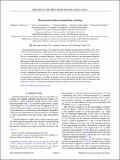Files in this item
Measurement-induced population switching
Item metadata
| dc.contributor.author | Ferguson, M.S. | |
| dc.contributor.author | Camenzind, L.C. | |
| dc.contributor.author | Müller, C. | |
| dc.contributor.author | Biesinger, D.E.F. | |
| dc.contributor.author | Scheller, C.P. | |
| dc.contributor.author | Braunecker, B. | |
| dc.contributor.author | Zumbühl, D.M. | |
| dc.contributor.author | Zilberberg, O. | |
| dc.date.accessioned | 2023-05-03T09:30:14Z | |
| dc.date.available | 2023-05-03T09:30:14Z | |
| dc.date.issued | 2023-06-01 | |
| dc.identifier | 285324247 | |
| dc.identifier | 21464387-8ef3-4eef-9775-e898f2108a1a | |
| dc.identifier | 85153519476 | |
| dc.identifier.citation | Ferguson , M S , Camenzind , L C , Müller , C , Biesinger , D E F , Scheller , C P , Braunecker , B , Zumbühl , D M & Zilberberg , O 2023 , ' Measurement-induced population switching ' , Physical Review Research , vol. 5 , no. 2 , 023028 . https://doi.org/10.1103/PhysRevResearch.5.023028 | en |
| dc.identifier.issn | 2643-1564 | |
| dc.identifier.other | RIS: urn:BFC37AA9CFA69503A8AAD52A0DC260CF | |
| dc.identifier.other | ORCID: /0000-0002-7077-8825/work/134491418 | |
| dc.identifier.uri | https://hdl.handle.net/10023/27492 | |
| dc.description | Funding: Work in Basel was supported by the Swiss Nanoscience Institute, Grant No. 179024 and NCCR SPIN of the Swiss National Science Foundation, ERC Starting Grant (D.M.Z.), and the EU H2020 European Microkelvin Platform EMP, Grant No. 824109. L.C.C. acknowledges support by Swiss NSF Mobility Fellowship No. P2BSP2 200127. C.P.S. further acknowledges support by the Georg H. Endress Foundation. The authors at ETH and IBM acknowledge financial support from the Swiss National Science Fund directly, and through NCCR QSIT. O.Z. acknowledges support from the Deutsche Forschungsgemeinschaft (DFG), Project No. 449653034. | en |
| dc.description.abstract | Quantum information processing is a key technology in the ongoing second quantum revolution, with a wide variety of hardware platforms competing toward its realization. An indispensable component of such hardware is a measurement device, i.e., a quantum detector that is used to determine the outcome of a computation. The act of measurement in quantum mechanics, however, is naturally invasive as the measurement apparatus becomes entangled with the system that it observes. This always leads to a disturbance in the observed system, a phenomenon called quantum measurement backaction, which should solely lead to the collapse of the quantum wave function and the physical realization of the measurement postulate of quantum mechanics. Here we demonstrate that backaction can fundamentally change the quantum system through the detection process. For quantum information processing, this means that the readout alters the system in such a way that a faulty measurement outcome is obtained. Specifically, we report a backaction-induced population switching, where the bare presence of weak, nonprojective measurements by an adjacent charge sensor inverts the electronic charge configuration of a semiconductor double quantum dot system. The transition region grows with measurement strength and is suppressed by temperature, in excellent agreement with our coherent quantum backaction model. Our result exposes backaction channels that appear at the interplay between the detector and the system environments, and opens new avenues for controlling and mitigating backaction effects in future quantum technologies. | |
| dc.format.extent | 13 | |
| dc.format.extent | 1635097 | |
| dc.language.iso | eng | |
| dc.relation.ispartof | Physical Review Research | en |
| dc.subject | QC Physics | en |
| dc.subject | NDAS | en |
| dc.subject | MCC | en |
| dc.subject.lcc | QC | en |
| dc.title | Measurement-induced population switching | en |
| dc.type | Journal article | en |
| dc.contributor.institution | University of St Andrews. School of Physics and Astronomy | en |
| dc.contributor.institution | University of St Andrews. Centre for Designer Quantum Materials | en |
| dc.contributor.institution | University of St Andrews. Condensed Matter Physics | en |
| dc.identifier.doi | 10.1103/PhysRevResearch.5.023028 | |
| dc.description.status | Peer reviewed | en |
This item appears in the following Collection(s)
Items in the St Andrews Research Repository are protected by copyright, with all rights reserved, unless otherwise indicated.

